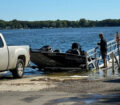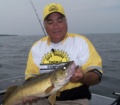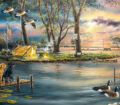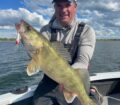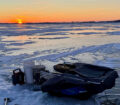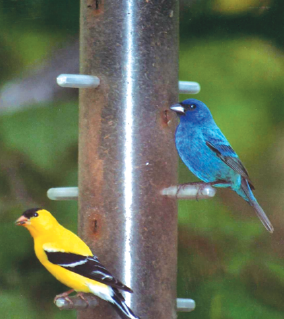By Bob Jensen
Fishing the Midwest Fishing Team
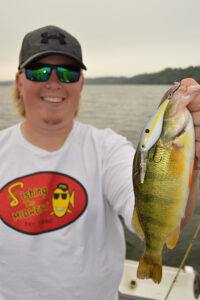
(photo by Bob Jensen) Oversized perch will, at times, eagerly take a fast moving crankbait in the summer.
Fish are cold-blooded. Water temperature effects how they go about their lives. When the water is cold, the fish prefer a slow moving bait. Their metabolism is slower in cold water, so they don’t move as fast.
When water temperatures warm up, like they do in the summer, fish will move around more, and they’ll also be willing to chase down a faster moving bait.
In the summer, speed-trolling can be a good way to catch fish. You can cover water faster while speed-trolling, so you’re putting your bait in front of more fish. That increases your chances for getting bit.
A faster moving bait is also more attractive to fish in the summer. Maybe it’s not more attractive:Maybe the faster moving bait just makes the fish react to it. There have been lots of times down through the years when we’ll troll through a school of fish at a mile an hour and nothing happens: The fish don’t react to our bait.
Then we go back through the school at two miles per hour and the fish get more interested and we catch a couple. That tips us off that, on that day, maybe even at that time of day, a faster presentation will do the job better. The fish can see a slower moving bait more clearly and sometimes will refuse it. If the bait is moving fast, the fish must react quicker. Either they eat or they don’t. Much of the time they do.
Speed-trolling appeals to a wide variety of fish. Muskies and northern pike willingly eat fast moving baits in the summer. So do walleyes, smallmouth and largemouth bass.
How fast do you go when speed-trolling? Many sonar units will display trolling speed. Some anglers report catching fish trolling three and four miles an hour, but that’s probably faster than you need to go much of the time. Two miles an hour is a good starting point. When a fish hits, quickly check the speed, then match it when you get your bait back in the water.
When I first started fishing, the best motors for trolling were usually fifty horsepower and under. More powerful motors didn’t work as well. They weren’t meant to go slow. Today’s larger horsepower motors troll effectively when conditions are right, and modern electric motors do a good job of trolling also.
A variety of baits work well for trolling. If walleyes are the target, start with a #5 Hornet. Spinners tipped with crawlers or plastic will also be good. Be sure that the bait is running at or just above the depth that the fish are at. Crankbaits will take muskies and pike, but bucktails and spoons work well also.
Different anglers have different preferences when it comes to a line for trolling. Some like no-stretch braided line, others like the forgiveness that some-stretch monofilament offers. If you choose to go the no-stretch route, you’ll want to use a longer, softer action rod.
The softer action is more forgiving, so you’ll land almost all of the fish that hit. You want the rod to have some bend in it as you troll. When a fish hits, the rod will just bend over. The hook will set itself.
From now and until autumn when the water starts cooling, try trolling faster than you ordinarily would. You might find that when you troll faster, you catch fish faster.


